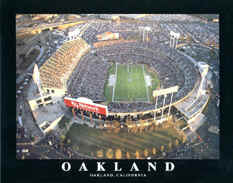Post by TheShadow on Sept 11, 2004 10:45:55 GMT -5

www.mercurynews.com
By Dennis Georgatos
Mercury News
Professional football in the Bay Area boils down to a simple formula:
Two NFL teams plus eight combined titles equals one football-mad market.
But for all the lore and success of the 49ers and Raiders, one thing doesn't compute: The Bay Area has hosted only one Super Bowl. That was almost 20 years ago. And it doesn't figure to happen again for a long, long time.
California has been prime Super Bowl territory, but outside of the 1985 game at Stanford Stadium, the games have been strictly SoCal affairs, with San Diego, Los Angeles and Pasadena the sites of 10 of them.
But folks around here need only look at two foreboding structures to know why the Bay Area has been shut out for so long. The Raiders play in a stadium that opened in 1966. Since 1971, the 49ers have been at Candlestick Park, built 44 years ago as the home of baseball's Giants.
The Bay Area has so much to offer football fans and nowhere to put them.
``San Francisco is one of the most attractive cities in the country and that's a plus, but we don't have a stadium around here that fits the needs of a Super Bowl,'' said former 49ers general manager and coach Bill Walsh.
That's also the view from the top of the NFL.
``Certainly, at this stage, the fact that there is not a high-quality, state-of-the-art football stadium certainly would be a consideration,'' Commissioner Paul Tagliabue said last spring.
Walsh, now a special assistant to Stanford Athletic Director Ted Leland, won the second of his three titles when he guided the 49ers to a 38-16 victory over Miami in Super Bowl XIX at Stanford Stadium in 1985.
Quentin Kopp, a former San Francisco supervisor who headed the Bay Area Super Bowl task force that landed that game, said it couldn't happen today.
Former NFL commissioner ``Pete Rozelle was still living and he had publicly stated that he wanted a Super Bowl in the Bay Area. That was No. 1,'' said Kopp, now a San Mateo County Superior Court judge. ``No. 2, the owners were looking for a large stadium, and Stanford had 80,000 seats. It also came with a brilliant brand name. Add all the attractions of the Bay Area, and that was very persuasive to the owners. But now, that's not nearly enough. It's almost irrelevant.''
Kopp joined other civic leaders in an effort two years later to land another Super Bowl. But the bid was derailed by the lack of sky boxes and the predominance of bench seating at Stanford. The alternative venue, Candlestick Park, was really no alternative at all. This was the place that former 49ers owner Eddie DeBartolo once called ``a pig sty.''
A decade later, NFL owners awarded San Francisco the 2003 Super Bowl contingent on a new stadium to replace Candlestick Park. In June 1997, San Francisco voters approved a $100 million bond to help finance a new stadium and mall.
That's where things stand today.
49ers owners Denise DeBartolo York and John York, who inherited the project from Eddie DeBartolo, put it on hold after cost estimates soared past $500 million from the original $350 million.
``As soon as that's built, there'll be another Super Bowl here -- and good luck on that one,'' Walsh said.
York, through a team spokesman, declined to comment on the prospects for a new stadium. The 49ers' lease at Candlestick Park expires in three years, and York hasn't publicly discussed whether the team would continue to play there beyond 2007.
Catering to the new
During the NFL meetings in Palm Beach, Fla., in March, York was asked why the Bay Area has hosted only one Super Bowl.
``Why do you think?'' he shot back.
The answer seems clear.
Since 2000, nine of the league's 32 teams have settled into new digs -- sleek stadiums that cater to single-ticket fans and the big-money patrons who drive the teams' economics. Cincinnati, Denver, Pittsburgh, Detroit, Houston, New England, Seattle, Chicago, Philadelphia -- they all have new homes.
The 49ers and the Raiders have old ones.
``If you look around,'' Walsh said, ``the newer stadiums have so much more to offer in the way of amenities and in addressing the needs of fans, television, the media and the NFL. They are just head and shoulders ahead of us here.''
Even Kopp, who opposed the 49ers' 1997 stadium plan as a ``foolish venture'' overly reliant on public funds, said that Candlestick Park could probably be used for only four or five more years.
Financing for a new stadium remains the most vexing problem, Kopp said. He doesn't see a public appetite for funding beyond the $100 million in bonds -- partly because of the economic climate and partly because of the Giants, who privately financed their new ballpark in downtown San Francisco.
Walsh said Network Associates Coliseum, which underwent a nearly $200 million reconstruction after the Raiders returned in 1995, comes closest to meeting the NFL's preferences for a Super Bowl. But it's still lacking in major ways. It doesn't have enough seats (63,000) and it's old.
Amy Trask, the Raiders' chief executive officer, said the team made a serious effort to land a Super Bowl after San Francisco relinquished its rights to the 2003 game but was ``met with resistance and indifference from city and county officials and the mayor's office.''
Oakland City Councilman Ignacio De La Fuente disputed Trask's claim but acknowledged `there was litigation between the Raiders and the city and I don't think we worked enough together. I don't want to blame them or anybody. We spent a lot of time and effort putting together a proposal. We made a presentation to the NFL. Unfortunately, we were not successful.''
How about L.A.?
In recent years, the NFL seems to be repaying communities that have invested in new stadiums by awarding Super Bowls. The expansion Houston Texans hosted the Super Bowl last season at 2-year-old Reliant Stadium. The NFL also has committed Super Bowls in 2005 to Jacksonville's Alltel Stadium, in 2006 to Detroit's Ford Field and in 2008 to Arizona, which is scheduled to have a new stadium in 2006.
The Bay Area has no stadium plans in the works, and no reason to expect a Super Bowl.
Indeed, Tagliabue noted that the 2003 Super Bowl, which was awarded to San Diego after San Francisco relinquished it, could be the last one played in California for some time because of the age of the state's NFL venues.
One potential answer lies in the league's attempts to return a team to Los Angeles -- which the league has said it would like to do by 2008. But that won't happen without plans for a new stadium.
``There's a sense of urgency about the whole effort,'' Tagliabue said. ``But you can't set a course until you cross the T's and dot the I's in terms of environmental reviews and structural analyses, and cost estimates.''

